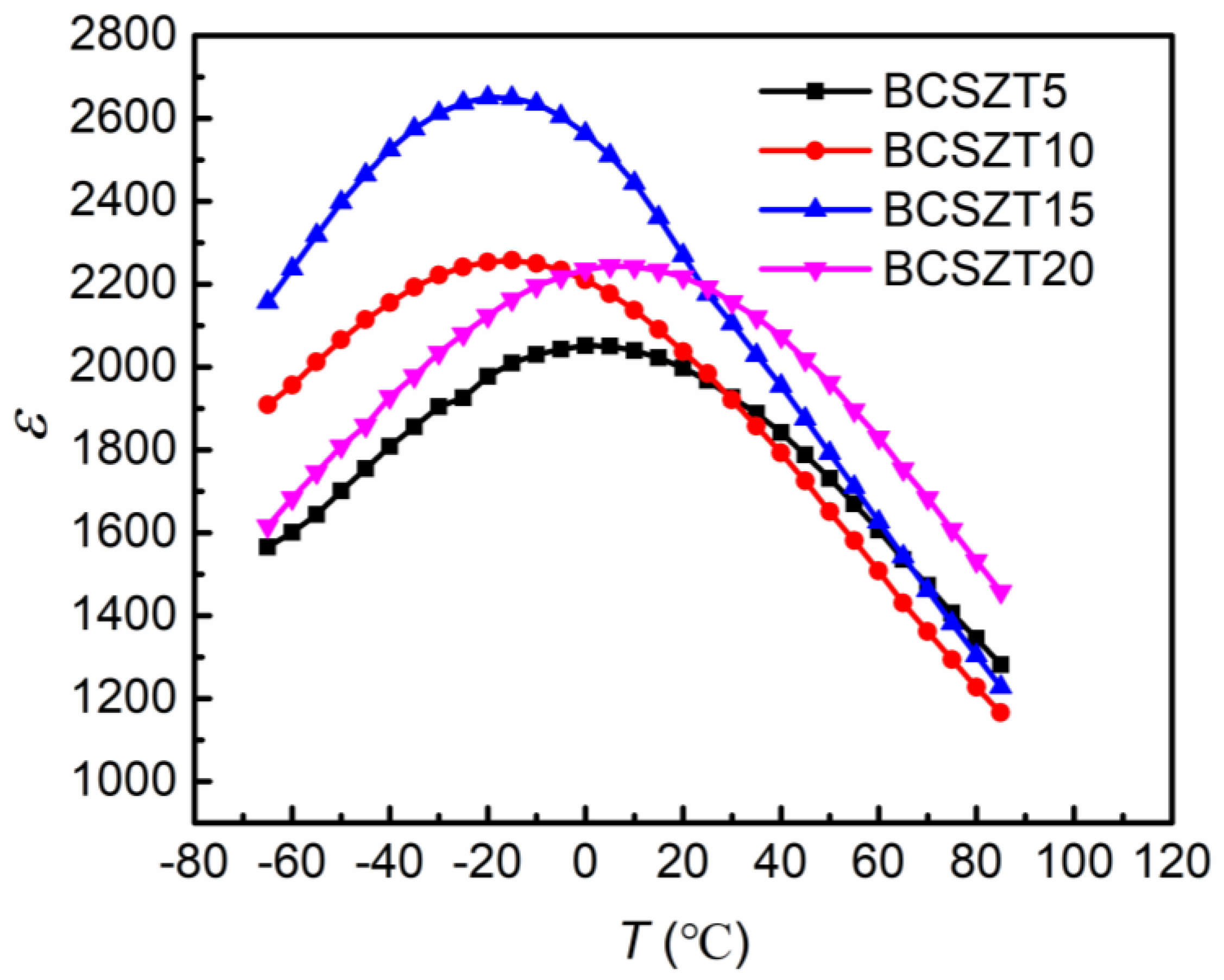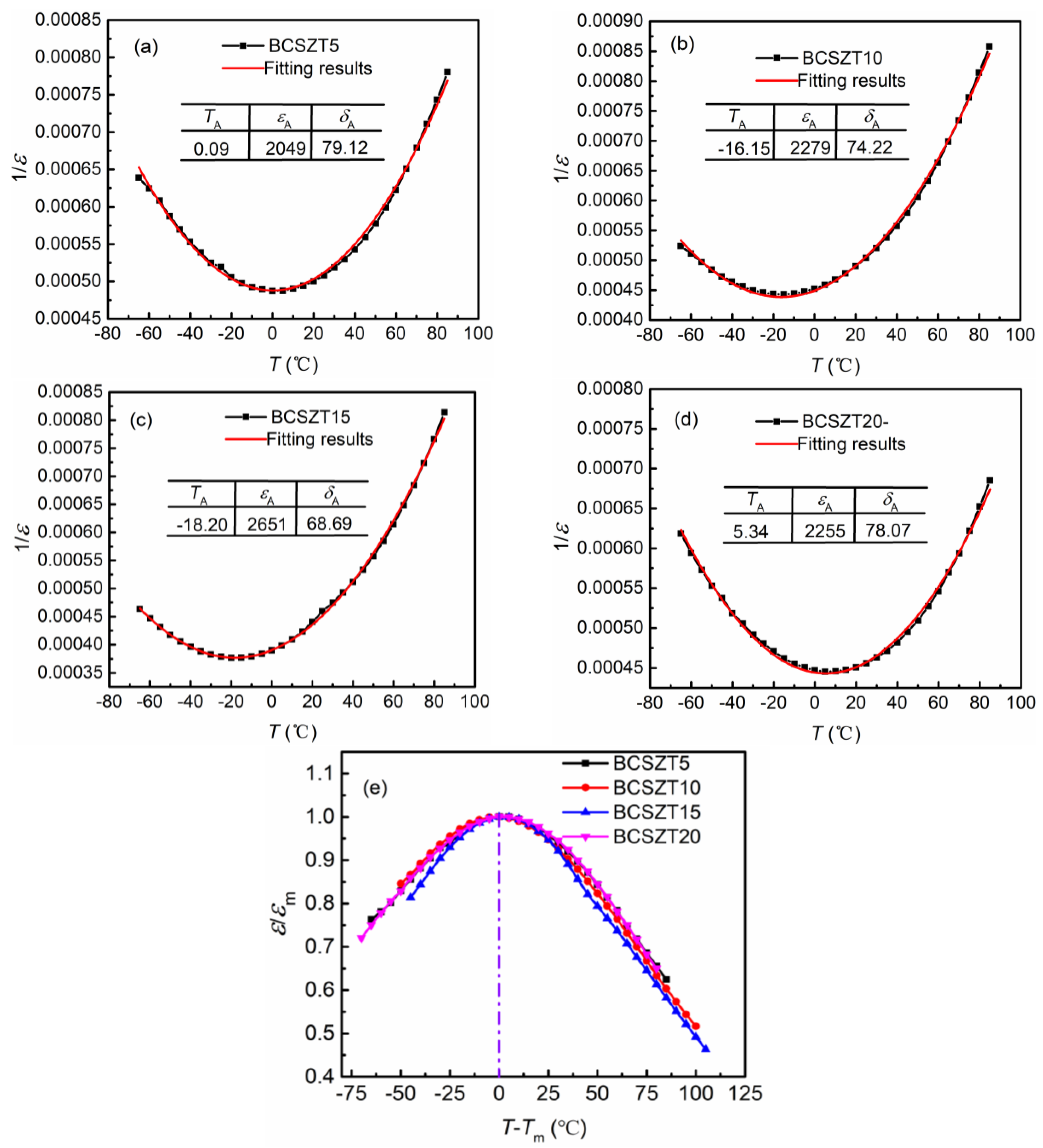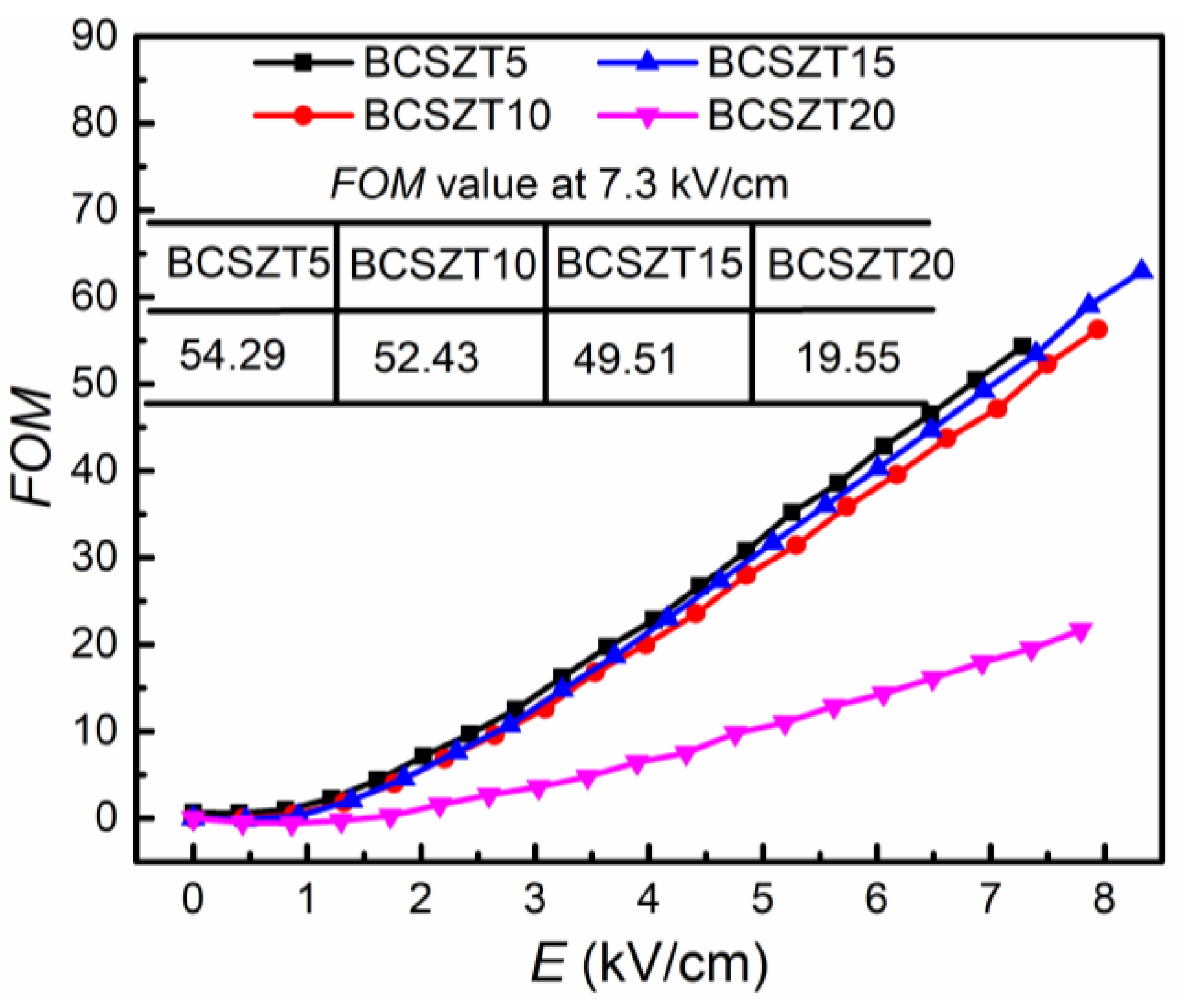Enhanced Tunability Achieving at Low Permittivity and Electric Field in (Ba0.91Ca0.09)(SnxZr0.2−xTi0.8)O3-2 mol% CuO-1 mol% Li2CO3 Ceramics
Abstract
1. Introduction
2. Experimental Procedures
3. Results and Discussion
4. Conclusions
Author Contributions
Funding
Institutional Review Board Statement
Informed Consent Statement
Data Availability Statement
Conflicts of Interest
References
- Bronckers, L.A.; Roc’h, A.; Smolders, A.B. A new design method for frequency-reconfigurable antennas using multiple tuning components. IEEE Trans. Antennas Propag. 2019, 67, 7285–7295. [Google Scholar] [CrossRef]
- Schuster, C.; Schynol, L.; Wentzel, A.; Huhn, F.; Polat, E.; Schmidt, S.; Jakoby, R.; Heinrich, W.; Maune, H. Concept for con-tinuously tunable output filters for digital transmitter architectures. IEEE Access 2019, 7, 123490–123504. [Google Scholar] [CrossRef]
- Gu, Z.; Pandya, S.; Samanta, A.; Liu, S.; Xiao, G.; Meyers, C.; Damodaran, A.; Barak, H.; Dasgupta, A.; Saremi, S.; et al. Resonant do-main-wall-enhanced tunable microwave ferroelectrics. Nature 2018, 560, 622–627. [Google Scholar] [CrossRef] [PubMed]
- Ushikoshi, D.; Higashiura, R.; Tachi, K.; Fathnan, A.A.; Mahmood, S.; Takeshita, H.; Homma, H.; Akram, M.R.; Vellucci, S.; Lee, J.; et al. Pulse-driven self-reconfigurable meta-antennas. Nat. Commun. 2023, 14, 633. [Google Scholar] [CrossRef] [PubMed]
- Shirkolaei, M.M.; Aslinezhad, M. Substrate integrated waveguide filter based on the magnetized ferrite with tunable capability. Microw. Opt. Technol. Lett. 2020, 63, 1120–1125. [Google Scholar] [CrossRef]
- Aspe, B.; Castel, X.; Demange, V.; Deputier, S.; Bouquet, V.; Benzerga, R.; Sauleau, R.; Guilloux-Viry, M. Frequency-tunable slot-loop antenna based on knn ferroelectric interdigitated varactors. IEEE Antennas Wirel. Propag. Lett. 2021, 20, 1414–1418. [Google Scholar] [CrossRef]
- Obuh, I.; Doychinov, V.; Steenson, D.; Akkaraekthalin, P.; Robertson, I.; Somjit, N. Low-cost microfabrication for MEMS switches and varactors, IEEE Transactions on Components. Packag. Manuf. Technol. 2018, 8, 1702–1710. [Google Scholar] [CrossRef]
- Liu, S.; Liao, J.; Huang, X.; Zhang, Z.; Wang, W.; Wang, X.; Shan, Y.; Li, P.; Hong, Y.; Peng, Z.; et al. Green fabrication of freestanding piezoceramic films for energy harvesting and virus detection. Nano-Micro Lett. 2023, 15, 131. [Google Scholar] [CrossRef]
- Ullah, S.; Hayat, S.; Umar, A.; Ali, U.; Tahir, F.; Flint, J.A. Design, fabrication and measurement of triple band frequency re-configurable antennas for portable wireless communications. AEU—Int. J. Electron. Commun. 2017, 81, 236–242. [Google Scholar] [CrossRef]
- Mirebrahimi, S.M.; Dousti, M.; Afrang, S. MEMS tunable filters based on DGS and waveguide structures: A literature review. Analog. Integr. Circuits Signal Process. 2021, 108, 141–164. [Google Scholar] [CrossRef]
- Chen, P.C.; Asbeck, P.M.; Dayeh, S.A. Freestanding high-power gan multi-fin camel diode varactors for wideband telecom tunable filters. IEEE Trans. Electron Devices 2023, 70, 963–970. [Google Scholar] [CrossRef]
- Bouca, P.; Figueiredo, R.; Matos, J.N.; Vilarinho, P.M.; Carvalho, N.B. Reconfigurable three functional dimension single and dual-band sdr front-ends using thin film bst-based varactors. IEEE Access 2022, 10, 4125–4136. [Google Scholar] [CrossRef]
- Berneti, E.K.; Ghalibafan, J. Tunable ferrite-based metamaterial structure and its application to a leaky-wave antenna. J. Magn. Magn. Mater. 2018, 456, 223–227. [Google Scholar] [CrossRef]
- Subramanyam, G.; Cole, M.; Sun, N.; Kalkur, T.; Sbrockey, N.; Tompa, G.; Guo, X.; Chen, C.; Alpay, S.; Rossetti, G.; et al. Challenges and opportunities for multi-functional oxide thin films for voltage tunable radio frequency/microwave components. J. Appl. Phys. 2013, 114, 191301. [Google Scholar] [CrossRef]
- Chou, X.; Wang, J.; Zhao, Z.; Geng, W.; Zhang, W.; Zhai, J. Dielectric tunability and microwave properties of Ba0.5Sr0.5TiO3-BaMg6Ti6O19 composite ceramics for tunable microwave device applications. J. Electroceram. 2011, 26, 185–190. [Google Scholar] [CrossRef]
- Menesklou, W.; Paul, F.; Zhou, X.; Elsenheimer, H.; Binder, J.R.; Ivers-Tiffée, E. Nonlinear ceramics for tunable microwave devices part I: Materials properties and processing. Microsyst. Technol. 2011, 17, 203–211. [Google Scholar] [CrossRef]
- Wang, W.; Zhang, M.; Xin, L.; Shen, S.; Zhai, J. Effect of interface behavior on dielectric properties of ferroelectric-dielectric composite ceramics. J. Alloys Compd. 2019, 809, 151712. [Google Scholar] [CrossRef]
- Zhang, M.; Xin, L.; Dong, Z.; Zhang, Y.; Jin, J.; Li, Z.; Xue, Y.; Ren, L.; Zhai, J. Structure and dielectric properties of Ba1-xSrxCuSi2O6-Ba0.55Sr0.45TiO3 ferroelectric-dielectric composite ceramics. J. Mater. Sci. Mater. Electron. 2021, 32, 21318–21325. [Google Scholar] [CrossRef]
- Xu, Z.; Fu, Z.; Ling, F.; Xu, Y. Simultaneously with lower permittivity and higher tunability achieved in Ba0.5Sr0.5TiO3-Mg2SiO4-MgO composite ceramics prepared by spark plasma sintering. J. Mater. Sci. Mater. Electron. 2022, 33, 23630–23638. [Google Scholar] [CrossRef]
- Ali, A.F.; Mahmoud, A.E.-R.; Gami, F.; Nassary, M.M.; Parashar, S.K.S. Enhancement of tunability properties of (Ba0.95Ca0.05)tio3 lead free ceramic by bawo4 for microwave applications. J. Electron. Mater. 2019, 48, 2940–2949. [Google Scholar] [CrossRef]
- Wang, R.-X.; Zhang, J.; Zheng, L.-M.; Sun, L.; Luo, Z.-L.; Zhang, S.-T.; Yang, B. Evolution of polar nano-regions under electric field around ferro-paraelectric transition temperature and its contribution to piezoelectric property in Pb(Mg1/3Nb2/3)O3-0.30PbTiO3 crystal. Ceram. Int. 2018, 44, 18084–18089. [Google Scholar] [CrossRef]
- Xu, Q.; Zhan, D.; Liu, H.-X.; Chen, W.; Huang, D.-P.; Zhang, F. Evolution of dielectric properties in BaZrxTi1−xO3 ceramics: Effect of polar nano-regions. Acta Mater. 2013, 61, 4481–4489. [Google Scholar] [CrossRef]
- Zhang, X.-F.; Xu, Q.; Liu, H.-X.; Chen, W.; Chen, M.; Kim, B.-H. Field history dependence of nonlinear dielectric properties of Ba0.6Sr0.4TiO3 ceramics under bias electric field: Polarization behavior of polar nano-regions. Phys. B Condens. Matter 2011, 406, 1571–1576. [Google Scholar] [CrossRef]
- Yang, P.; Peng, W.; Xu, K.; Li, L.; Yu, S. The effect of Li2CO3 sintering additive on the dielectric and tunable performance of (Ba0.91Ca0.09)(Zr0.2Ti0.8)O3-CuO ceramics. Ceram. Int. 2021, 47, 23571–23577. [Google Scholar] [CrossRef]
- Shi, T.; Xie, L.; Gu, L.; Zhu, J. Why Sn doping significantly enhances the dielectric properties of Ba(Ti1−xSnx)O3. Sci. Rep. 2015, 5, 8606. [Google Scholar] [CrossRef] [PubMed]
- Yang, P.; Zhao, L.; Wang, B.; Zhang, L.; Yu, S. Enhanced dielectric and tunable performance in BCZT91/BCZT87 bilayer ce-ramics. Ceram. Int. 2023, 49, 16918–16923. [Google Scholar] [CrossRef]
- Zhao, B.; Zhu, Q.; Sun, X.; Li, J.-G. Co-doping Zn2+/Sn4+ in ZnGa2O4:Cr3+ for dynamic near-infrared luminescence and advanced anti-counterfeiting. Ceram. Int. 2021, 47, 17000–17007. [Google Scholar] [CrossRef]
- Li, J.; Peng, T.; Zhang, Y.; Zhou, C.; Zhu, A. Polyaniline modified SnO2 nanoparticles for efficient photocatalytic reduction of aqueous Cr(VI) under visible light. Sep. Purif. Technol. 2018, 201, 120–129. [Google Scholar] [CrossRef]
- Wu, B.; Ma, J.; Wu, W.; Chen, M. Microstructure, phase structure, and electrical properties of Zr-modified BaTiO3-based lead-free ceramics. J. Mater. Sci. Mater. Electron. 2017, 29, 1584–1591. [Google Scholar] [CrossRef]
- Wang, H.; Wu, J. Ba0.95Ca0.05Ti0.92Sn0.08-xZrxO3 lead-free ceramics: Microstructure and piezoelectricity. J. Mater. Sci. Mater. Electron. 2015, 26, 4119–4123. [Google Scholar] [CrossRef]
- Chihaoui, S.; Seveyrat, L.; Perrin, V.; Kallel, I.; Lebrun, L.; Khemakhem, H. Structural evolution and electrical characteristics of Sn-doped Ba0.8Sr0.2TiO3 ceramics. Ceram. Int. 2017, 43, 427–432. [Google Scholar] [CrossRef]
- Schultheiß, J.; Checchia, S.; Uršič, H.; Frömling, T.; Daniels, J.; Malič, B.; Rojac, T.; Koruza, J. Domain wall-grain boundary interactions in polycrystalline Pb(Zr0.7Ti0.3)O3 piezoceramics. J. Eur. Ceram. Soc. 2020, 40, 3965–3973. [Google Scholar] [CrossRef]
- Tan, Y.; Viola, G.; Koval, V.; Yu, C.; Mahajan, A.; Zhang, J.; Zhang, H.; Zhou, X.; Tarakina, N.; Yan, H. On the origin of grain size effects in Ba(Ti0.96Sn0.04)O3 perovskite ceramics. J. Eur. Ceram. Soc. 2019, 39, 2064–2075. [Google Scholar] [CrossRef]
- Liu, Q.; Zhang, Y.; Gao, J.; Zhou, Z.; Wang, H.; Wang, K.; Zhang, X.; Li, L.; Li, J.-F. High-performance lead-free piezoelectrics with local structural heterogeneity. Energy Environ. Sci. 2018, 11, 3531–3539. [Google Scholar] [CrossRef]
- Auromun, K.; Acharya, T.; Choudhary, R. Octahedral distortion-driven phase transition, relaxation and conduction process of Zr/Sn modified barium titanate relaxors. Ceram. Int. 2022, 48, 20858–20871. [Google Scholar] [CrossRef]
- Talanov, M.V.; Bush, A.A.; Sirotinkin, V.P.; Kozlov, V.I. Structural origin of strongly diffused ferroelectric phase transition in Ba(Ti, Zr)O3-based ceramics. Acta Mater. 2022, 227, 117734. [Google Scholar] [CrossRef]
- Tsuji, K.; Ndayishimiye, A.; Lowum, S.; Floyd, R.; Wang, K.; Wetherington, M.; Maria, J.-P.; Randall, C.A. Single step densifi-cation of high permittivity BaTiO3 ceramics at 300 °C. J. Eur. Ceram. Soc. 2020, 40, 1280–1284. [Google Scholar] [CrossRef]
- Coondoo, I.; Panwar, N.; Alikin, D.; Bdikin, I.; Islam, S.S.; Turygin, A.; Shur, V.Y.; Kholkin, A.L. A comparative study of structural and electrical properties in lead-free BCZT ceramics: Influence of the synthesis method. Acta Mater. 2018, 155, 331–342. [Google Scholar] [CrossRef]
- Liu, L.; Ren, S.; Zhang, J.; Peng, B.; Fang, L.; Wang, D. Revisiting the temperature-dependent dielectric permittivity of Ba(Ti1-xZrx)O3. J. Am. Ceram. Soc. 2018, 101, 2408–2416. [Google Scholar] [CrossRef]
- Fu, X.; Cai, W.; Cheng, G.; Gao, R. Effects of Sn doping on the microstructure and dielectric and ferroelectric properties of Ba(Zr0.2Ti0.8)O3 ceramics. J. Mater. Sci. Mater. Electron. 2017, 28, 8177–8185. [Google Scholar] [CrossRef]
- Ren, P.; Wang, Q.; Li, S.; Zhao, G. Energy storage density and tunable dielectric properties of BaTi0.85Sn0.15O3/MgO composite ceramics prepared by SPS. J. Eur. Ceram. Soc. 2017, 37, 1501–1507. [Google Scholar] [CrossRef]
- Mahmoud, A.E.-R.; Babeer, A.M. Intrinsic and extrinsic contributions in nonlinear dielectric response of (Bi0.5Na0.3K0.2)TiO3-(Ba0.8Ca0.2)TiO3-Based SrTiO3 ceramics driven by the rayleigh model. J. Electron. Mater. 2021, 51, 378–390. [Google Scholar] [CrossRef]
- Kumar, V.; Jaiswal, M.; Gupta, R.; Ram, J.; Sulania, I.; Ojha, S.; Sun, X.; Koratkar, N.; Kumar, R. Effect of low energy (keV) ion irradiation on structural, optical and morphological properties of SnO2-TiO2 nanocomposite thin films. J. Mater. Sci. Mater. Electron. 2018, 29, 13328–13336. [Google Scholar] [CrossRef]
- Xiaoqing, L.W. Synthesis of high temperature resistant ZrO2-SiO2 composite aerogels via supercritical fluid deposition. Indian J. Chem. Technol. 2023, 30, 198–204. [Google Scholar]
- Chou, X.; Zhai, J.; Yao, X. Dielectric tunable properties of low dielectric constant Ba0.5Sr0.5TiO3–Mg2TiO4 microwave composite ceramics. Appl. Phys. Lett. 2007, 91, 122908. [Google Scholar] [CrossRef]
- Lu, X.; Tong, Y.; Zhang, L.; Ma, B.; Cheng, Z.-Y. High dielectric tunability in composites prepared using SiO2 coated Ba0.5Sr0.5TiO3 nanoparticles. Ceram. Int. 2018, 44, 9875–9879. [Google Scholar] [CrossRef]
- Liang, R.; Zhou, Z.; Dong, X.; Wang, G.; Cao, F.; Hu, Z.; Jiang, K. Enhanced dielectric tunability of Ba0.55Sr0.45TiO3-ZnAl2O4 composite ceramic. Ceram. Int. 2015, 41, S551–S556. [Google Scholar] [CrossRef]
- Ren, P.; Fan, H.; Wang, X.; Tan, X. Modified tunable dielectric properties by addition of MgO on BaZr0.25Ti0.75O3 ceramics. Mater. Res. Bull. 2011, 46, 2308–2311. [Google Scholar] [CrossRef]
- Valant, M.; Suvorov, D. Low-temperature sintering of (Ba0.6Sr0.4)TiO3. J. Am. Ceram. Soc. 2004, 87, 1222–1226. [Google Scholar] [CrossRef]
- Liu, G.; Li, Y.; Gao, J.; Li, D.; Yu, L.; Dong, J.; Zhang, Y.; Yan, Y.; Fan, B.; Liu, X.; et al. Structure evolution, ferroelectric properties, and energy storage performance of CaSnO3 modified BaTiO3-based Pb-free ceramics. J. Alloys Compd. 2020, 826, 154160. [Google Scholar] [CrossRef]
- Liu, Z.; Fan, H.; Long, C. Dielectric nonlinearity and electrical properties of K0.5Na0.5NbO3–SrTiO3 relaxor ferroelectrics. J. Mater. Sci. 2014, 49, 8107–8115. [Google Scholar] [CrossRef]
- Liu, G.; Li, Y.; Shi, M.; Yu, L.; Chen, P.; Yu, K.; Yan, Y.; Jin, L.; Wang, D.; Gao, J. An investigation of the dielectric energy storage performance of Bi(Mg2/3Nb1/3)O3-modifed BaTiO3 Pb-free bulk ceramics with improved temperature/frequency stability. Ceram. Int. 2019, 45, 19189–19196. [Google Scholar] [CrossRef]






| Samples | Sintering Temperature (°C) | ε(0) | Tunability@Working Electric Field | Ref. |
|---|---|---|---|---|
| Ba0.5Sr0.5TiO3 | 1400 | 2500 | 22.7% (30 kV/cm) | [45] |
| Ba0.5Sr0.5TiO3 | 1230 | ~1746 | 47% (100 kV/cm) | [46] |
| Ba0.55Sr0.45TiO3-20 wt% ZnAl2O4 | 1400 | 2362 | 46.4% (20 kV/cm) | [47] |
| BaZr0.25Ti0.75O3-10 wt%MgO | 1350 | 1821 | 38.2% (10 kV/cm) | [48] |
| Ba0.6Sr0.4TiO3+ 0.8 wt% Li2O | 900 | 1900 | 16.4% (30 kV/cm) | [49] |
| 0.95BaTiO3-0.05 CaSnO3 | 1400 | ~2100 | 21.15% (30 kV/cm) | [50] |
| K0.5Na0.5NbO3-0.2SrTiO3 | 1250 | 1126 | 17.4% (50 kV/cm) | [51] |
| 0.875BaTiO3-0.125Bi(Mg2/3Nb1/3)O3 | 1250 | ~1050 | <3% (40 kV/cm) | [52] |
| BCSZT5 | 1100 | 1913 | 26.55% (7.3 kV/cm) | This work |
Disclaimer/Publisher’s Note: The statements, opinions and data contained in all publications are solely those of the individual author(s) and contributor(s) and not of MDPI and/or the editor(s). MDPI and/or the editor(s) disclaim responsibility for any injury to people or property resulting from any ideas, methods, instructions or products referred to in the content. |
© 2023 by the authors. Licensee MDPI, Basel, Switzerland. This article is an open access article distributed under the terms and conditions of the Creative Commons Attribution (CC BY) license (https://creativecommons.org/licenses/by/4.0/).
Share and Cite
Wang, B.; Zhao, L.; Jia, X.; Yang, P.; Yu, S. Enhanced Tunability Achieving at Low Permittivity and Electric Field in (Ba0.91Ca0.09)(SnxZr0.2−xTi0.8)O3-2 mol% CuO-1 mol% Li2CO3 Ceramics. Materials 2023, 16, 5226. https://doi.org/10.3390/ma16155226
Wang B, Zhao L, Jia X, Yang P, Yu S. Enhanced Tunability Achieving at Low Permittivity and Electric Field in (Ba0.91Ca0.09)(SnxZr0.2−xTi0.8)O3-2 mol% CuO-1 mol% Li2CO3 Ceramics. Materials. 2023; 16(15):5226. https://doi.org/10.3390/ma16155226
Chicago/Turabian StyleWang, Bo, Le Zhao, Xiuhuai Jia, Pan Yang, and Shihui Yu. 2023. "Enhanced Tunability Achieving at Low Permittivity and Electric Field in (Ba0.91Ca0.09)(SnxZr0.2−xTi0.8)O3-2 mol% CuO-1 mol% Li2CO3 Ceramics" Materials 16, no. 15: 5226. https://doi.org/10.3390/ma16155226
APA StyleWang, B., Zhao, L., Jia, X., Yang, P., & Yu, S. (2023). Enhanced Tunability Achieving at Low Permittivity and Electric Field in (Ba0.91Ca0.09)(SnxZr0.2−xTi0.8)O3-2 mol% CuO-1 mol% Li2CO3 Ceramics. Materials, 16(15), 5226. https://doi.org/10.3390/ma16155226






